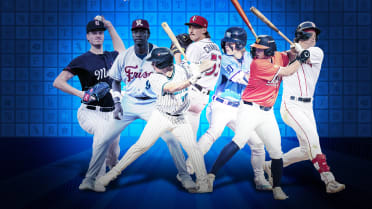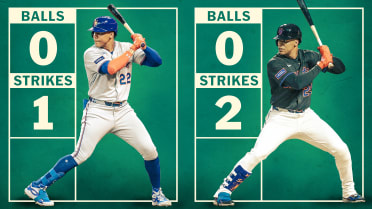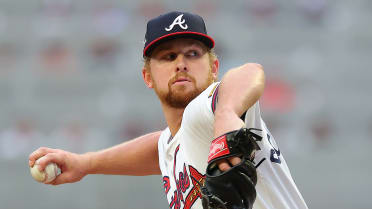The more Josh Hader kept rolling through the 2023 season, the more his 2022 stat line looked like a blip. It was just too un-Hader-like.
A 5.22 ERA? Was that really Josh Hader? The Josh Hader we're talking about has a 2.10 ERA across all the seasons of his career not named "2022." But for a good stretch around his trade from the Brewers to the Padres in the summer of '22, Hader really was getting crushed. The left-hander was struggling with his mechanics. He was giving up way too much hard contact. It could have turned into something serious to worry about, with Hader going into a contract year in 2023.
Instead, he erased any concerns. First, Hader got his mechanics together in time to have a dominant 2022 postseason for San Diego. Then he made a couple more tweaks entering the 2023 season and kept dominating all year, to the tune of a 1.28 ERA.
Now he's going to be an Astro. And Houston is getting the No. 1 closer out there.
The Astros are getting a Hader who's back at full power -- that's why they're reportedly bringing him in on a five-year $95 million deal, as a source told MLB.com's Mark Feinsand on Friday. A powerhouse Houston team seeking its third World Series title in eight years just got more powerful; a bullpen with an elite back-end duo in Ryan Pressly and Bryan Abreu now has an even more elite back-end trio.
Here's how Hader buried his issues and cemented himself as the best reliever on the free-agent market before the Astros snapped him up.
Eliminating hard contact … again
Earlier in his career, the one chance you had against Hader was that if you somehow made contact, you could maybe drive the ball against him. Hader has always had elite strikeout numbers -- he's never had a strikeout rate below 36% in his career, while most pitchers will never even have one season that high -- but those also used to be coupled with high hard-hit rates and barrel rates allowed.
Now, that didn't matter too much, because so few hitters could make contact against Hader in the first place. Still, he had seemed to solve his one issue by 2021. He kept up his ridiculous strikeout rates, but also cut down on his hard contact allowed. It was arguably the best all-around season of his career.
But then came 2022, and Hader's hard-hit issues returned -- and led to the blowup games that made his ERA balloon over 5.
He had to fix things again in 2023. And he did.
Hader cut down on his hard contact allowed last year the same way he did in 2021. And the result was a similarly dominant season: Hader's 1.28 ERA in 61 games in 2023 nearly matched his 1.23 ERA in 60 games in 2021. The blowup games disappeared. Hader allowed three or more runs in a game five times between July and August 2022; he didn't allow three runs in a game all year in 2023.
Here's what Hader's quality-of-contact numbers look like over his last four full seasons (excluding the shortened 2020). Check out how he's made the same improvement, twice -- reducing hard contact, while maintaining his strikeout numbers -- first between 2019 and 2021, and again from 2022 to 2023.
2019 to 2021
- Hard-hit rate: 42.0% (9th percentile) ➡️ 30.2% (95th percentile)
- Barrel rate: 12.6% (1st percentile) ➡️ 6.3% (72nd percentile)
- Whiff rate: 41.8% (100th percentile) ↔️ 45.2% (100th percentile)
- Strikeout rate: 47.8% (100th percentile) ↔️ 45.5% (100th percentile)
2022 to 2023
- Hard-hit rate: 36.3% (63rd percentile) ➡️ 28.3% (97th percentile)
- Barrel rate: 11.5% (4th percentile) ➡️ 4.4% (92nd percentile)
- Whiff rate: 36.6% (97th percentile) ↔️ 33.1% (91st percentile)
- Strikeout rate: 37.0% (98th percentile) ↔️ 36.8% (99th percentile)
What he did this time
When Hader went from "shaky" back to "dominant" down the stretch in 2022, he was able to lean into his fastball and just overpower hitters. In the playoffs in particular, Hader dialed up his fastball usage and was able to elevate his heater more consistently.
That trend continued into 2023. Hader threw 73% fastballs compared to 23% sliders, his highest fastball usage and lowest slider usage in any of the last four years. He elevated his fastball 62% of the time, up from 56% in 2022, and his average fastball pitch height increased from 2.83 feet to 3.00 feet.
Hader has always had a great rising fastball, which plays the best at the top of the strike zone, but he generated more "rise" than ever in 2023. (What that really means is Hader's fastball dropped less on its way to the plate.)
Even though Hader's fastball velocity was a little lower in 2023, averaging 96.1 mph compared to 97.4 mph in 2022, it had the least amount of vertical drop for any season of his career. A fastball that doesn't drop looks to the hitter like it's rising, and will force a lot of swings-and-misses. Normally, a pitcher will get more rise if he's throwing his fastball harder, because the ball just has less time to drop on its way to the batter. But Hader was able to add rise without extra velo, which means he was creating that vertical movement from how he was spinning his heater.
Hader's fastball velocity and vertical drop by season
2017: 94.3 mph / 11.4 inches drop
2018: 94.5 mph / 13.5 inches drop
2019: 95.5 mph / 12.6 inches drop
2020: 94.5 mph / 13.6 inches drop
2021: 96.4 mph / 12.1 inches drop
2022: 97.4 mph / 11.3 inches drop
2023: 96.1 mph / 11.0 inches drop
Hader induced even more rise on his fastball in 2023 than we're used to seeing from him -- which is a lot to begin with. He's one of the only pitchers with such an explosive rising fastball, so he's one of the only pitchers who can throw that fastball three quarters of the time and still dominate.
But even with all those fastballs, Hader didn't really go away from his slider. The truth is more like the opposite. The slider was as important of an out pitch for him as it's ever been.
Hader's fastball is usually his No. 1 strikeout pitch by far. But in 2023, his fastball and slider were closer than in any other full season of his career: Hader got 48 strikeouts on his fastball, and 33 on his slider.
The two pitches are usually much farther apart. In 2022, for example, Hader had 51 K's on fastballs and 27 on sliders. In 2019, his most extreme season, he had 111 K's on fastballs and 23 on sliders.
Hader's slider usage vs. % of total K's coming on sliders
Full seasons only (excludes 2020)
2017: 11% usage / 12% of total K's
2018: 21% usage / 24% of total K's
2019: 16% usage / 17% of total K's
2021: 28% usage / 33% of total K's
2022: 28% usage / 33% of total K's
2023: 23% usage / 39% of total K's
In other words, Hader's slider, which generates an elite 52% swing-and-miss rate, is now accounting for an outsized share of his strikeouts, even though his overall usage is extremely fastball-heavy. That's one subtle way Hader has evolved as a pitcher.
He's updated his slider too, throwing it harder in 2023 -- a career-high 85.7 mph on average, up nearly two full mph from 84.0 mph in 2022 -- with tighter break than it's ever had. Hader's slider, which used to average about 8 inches of horizontal break early in his career, was down to 2 inches of break this year, the smallest number he's ever had. That's a power slider he can use to strike out hitters after they've seen all those fastballs.
Adjustments like that, which let Hader bounce back from struggles and stay one of baseball's best closers, should give the Astros plenty of confidence that he can keep doing what it takes to dominate as Houston tries to create a dynasty.
David Adler is a reporter for MLB.com based in New York.





